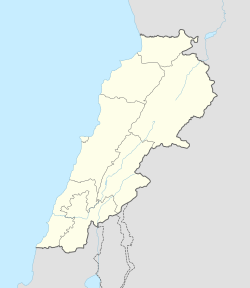 The temple excavations in 1950 | |
| Location | Byblos |
|---|---|
| Coordinates | 34°07′09″N 35°38′45″E / 34.11917°N 35.64583°E |
| Site notes | |
| Excavation dates | 1922 |
The Temple of Baalat Gebal (Arabic: معبد بعلة جبيل maebad baalat jbeil) was an important Bronze Age temple structure in the World Heritage Site of Byblos.[1] The temple was dedicated to Ba'alat Gebal, the goddess of the city of Byblos, known later to the Greeks as Atargatis.[2] Built in 2800 BCE,[3] it was the largest and most important sanctuary in ancient Byblos,[4] and is considered to be "one of the first monumental structures of the Syro-Palestinian region".[3] Two centuries after the construction of the Temple of Baalat Gebal, the Temple of the Obelisks was built approximately 100m to the east.[3]
The length and continuity of its history as an active temple is "remarkable" and "supports its centrality in the life of the city".[5]
An important group of Byblos figurines were found in the temple;[6][7][8] these figurines have become the "poster child" of the Lebanese Tourism Ministry.[9]
- ^ Boda 1994, p. 146.
- ^ Espinel, Andrés Diego (2002). "The Role of the Temple of Ba'alat Gebal as Intermediary between Egypt and Byblos during the Old Kingdom". Studien zur Altägyptischen Kultur. 30: 103–119. JSTOR 25152861.
- ^ a b c Bryce 2009, p. 138.
- ^ Kilani 2019, p. 53-54.
- ^ Kilani 2019, p. 54.
- ^ WorldWide: Lebanon, Biblical Archaeology Review 34:5, September/October 2008
- ^ Hakimian, Suzy (2008). "Byblos: Standing Figures". Beyond Babylon: Art, Trade, and Diplomacy in the Second Millennium B.C. Metropolitan Museum of Art. pp. 52–53. ISBN 978-1-58839-295-4.
More than fifteen hundred male figurines...
- ^ Aubet, Maria Eugenia (31 January 2013). Commerce and Colonization in the Ancient Near East. Cambridge University Press. pp. 240–. ISBN 978-0-521-51417-0.
The most characteristic assemblage of offerings is without doubt the bronze figurines representing Baal, many of them covered in gold plate. Almost 2,000 figurines of this type have been found — an important group coming from the Temple of Baalat Gebal — the majority in the Temple of the Obelisks, where more than twenty votive deposits and pitchers with figurines of different typologies have been found
- ^ Steiner, Margreet L.; Killebrew, Ann E. (2014). The Oxford Handbook of the Archaeology of the Levant: C. 8000-332 BCE. OUP Oxford. pp. 465–. ISBN 978-0-19-921297-2.

